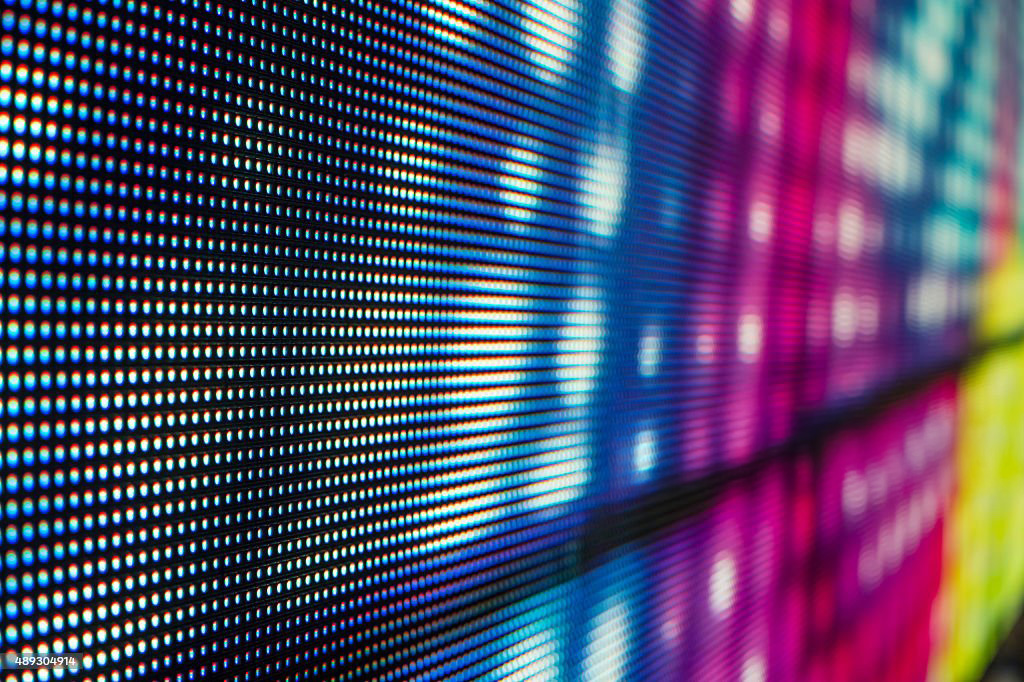Pixel Pitch Explained: A Complete 2025 Guide
Introduction
When selecting an LED screen, one of the most important specifications you’ll encounter is pixel pitch — the measurement that defines how sharp and detailed an image will appear.
Pixel pitch affects image quality, resolution, viewing distance, and cost.
This guide explains what pixel pitch means, how it impacts LED performance, and how to choose the right configuration for your project — from outdoor billboards to fine-pixel indoor displays and new MicroLED technology.
1. What Is Pixel Pitch?
Pixel pitch is the distance (in millimeters) between the centers of two adjacent pixels on an LED module.
For example:
-
A P2.5 screen has 2.5 mm spacing between pixels.
-
A P10 screen has 10 mm spacing between pixels.
The smaller the pitch, the closer the LEDs — resulting in higher pixel density and a sharper image.
Larger pixel pitches are better suited for large screens viewed from a distance, where extreme resolution isn’t required.
2. How Pixel Pitch Affects Image Quality
Pixel pitch determines how many LEDs fit in one square meter, which directly affects resolution.
Smaller pitches contain more pixels and therefore deliver finer detail and smoother gradients.
| Pixel Pitch | Approx. Image Quality | Typical Applications |
|---|---|---|
| P0.4 – P1.1 | Ultra-fine resolution (MicroLED / COB) | Studios, cinemas, boardrooms, control centers |
| P1.2 – P1.8 | Very high clarity | High-end indoor displays and showrooms |
| P2.0 – P2.9 | High definition | Retail, exhibitions, commercial interiors |
| P3.0 – P4.9 | Balanced clarity | Lobbies, semi-outdoor spaces |
| P5.0 – P8.0 | Medium resolution | Outdoor façades and signage |
| P10 + | Coarse resolution | Billboards, unipoles, long-distance viewers |
3. Understanding Resolution and Pixel Density
Unlike televisions, LED displays are modular — their resolution depends on pixel pitch and physical size rather than a fixed format like 1080p or 4K.
Resolution is the number of pixels across the screen (width × height).
Pixel density is how many pixels exist in one square meter.
A smaller pitch greatly increases both metrics.
| Pixel Pitch | Approx. Pixels / m² | Image Detail |
|---|---|---|
| P0.9 | ~1 230 000 | Ultra-fine; close-view MicroLED |
| P1.5 | ~440 000 | Very high; premium indoor |
| P2.5 | ~160 000 | High; standard indoor retail |
| P4 | ~62 500 | Medium; mixed-use |
| P6 | ~27 000 | Coarse; outdoor signage |
Example – 5 m × 3 m Display
| Pixel Pitch | Approx. Resolution (W × H) | Total Pixels |
|---|---|---|
| P0.9 | 5555 × 3333 | 18.5 million |
| P1.5 | 3333 × 2000 | 6.6 million |
| P2.5 | 2000 × 1200 | 2.4 million |
| P4 | 1250 × 750 | 937 000 |
| P10 | 500 × 300 | 150 000 |
Summary:
Reducing pixel pitch increases both resolution and pixel density — dramatically improving image quality but also increasing power use, data load, and cost.
4. Pixel Pitch and Viewing Distance
Each pixel pitch corresponds to an optimal viewing distance — the point where the image appears perfectly blended.
If viewers stand closer than this distance, pixels may become visible.
| Pixel Pitch | Recommended Viewing Distance | Environment |
|---|---|---|
| P0.4 – P0.9 | 0.5 – 1 m | MicroLED / fine-pixel indoor |
| P1.2 – P1.8 | 1 – 2 m | Indoor, short-range viewing |
| P2.5 – P3.9 | 2.5 – 4 m | Retail, lobby, exhibition |
| P4 – P6 | 4 – 8 m | Semi-outdoor or façades |
| P8 – P10 + | 8 – 15 m + | Billboards and unipoles |
5. Indoor vs. Outdoor LED Screens
-
Indoor LEDs use smaller pixel pitches (P0.9 – P3) for high resolution in close environments.
They prioritize contrast, color accuracy, and seamless assembly. -
Outdoor LEDs use larger pitches (P4 – P10 +) designed for long viewing distances, high brightness (6000–8000 nits), and weather resistance.
6. Fine-Pixel and MicroLED Displays
Fine-pixel LED (or narrow-pitch LED) refers to any display below P2 mm.
The newest generation — COB (Chip-on-Board) and IMD (Integrated Matrix Device) — has pushed limits down to P0.9, P0.6, and P0.4 mm.
These are often categorized as MicroLED.
Key Characteristics
-
Seamless visuals: No visible module lines; perfectly uniform surfaces.
-
High contrast & HDR capability: Ideal for broadcast and cinematic content.
-
Fine calibration: Color consistency across millions of sub-pixels.
-
Brightness: Typically 600–1200 nits — optimized for controlled indoor environments.
-
Durability: Up to 100 000 hours with precise thermal control.
Applications
| Pixel Pitch Range | Technology | Typical Use |
|---|---|---|
| P1.2 – P2.0 | SMD Fine-Pitch | Retail, auditoriums, control rooms |
| P0.9 – P0.6 | COB / IMD | Boardrooms, broadcast studios |
| P0.4 | MicroLED | Ultra-premium home cinema or prototype walls |
Fine-pixel LEDs offer stunning image fidelity but require specialized assembly, calibration, and air-conditioned environments — they’re not suitable for outdoor use.
7. Pixel Pitch and Technical Impact
Pixel pitch influences power consumption, controller load, and maintenance complexity.
| Pitch Range | LEDs / m² (approx.) | Relative Power Use |
|---|---|---|
| P0.4 – P1.0 | 1 000 000 + | Very High |
| P1.2 – P1.8 | 250 000 – 600 000 | High |
| P2.0 – P3.9 | 130 000 – 250 000 | Medium |
| P4.0 – P8.0 | 40 000 – 130 000 | Low – Medium |
| P10 + | 10 000 – 40 000 | Low |
Smaller pixel pitches require more driving circuits, processing power, and cooling capacity — all factors to consider in long-term system design.
8. Choosing the Right Pixel Pitch
There is no single “best” pixel pitch.
The right choice depends on your project’s requirements:
-
Viewing Distance – How close the audience will stand.
-
Installation Type – Indoor, semi-outdoor, or outdoor.
-
Displayed Content – Detail level, color accuracy, or animation.
-
Power and Budget Constraints – Finer pitch means higher investment and load.
Each LED project has its own conditions — environment, content, and architecture — so pixel pitch must always be chosen after evaluating the full context.
9. Quick Reference Chart
| Installation Type | Recommended Pixel Pitch Range | Notes |
|---|---|---|
| Indoor retail / lobby | P2.5 – P3.9 | Standard clarity for mid-range viewing |
| Control room / cinema | P0.9 – P1.5 | Fine-pitch LED for high precision |
| Broadcast / studio | P0.6 – P0.9 | COB / MicroLED for HDR and color uniformity |
| Outdoor façade | P4 – P6 | High brightness, wide viewing angle |
| Unipole / billboard | P8 – P10 + | Long-range visibility, economical |
| 3D corner LED | P4 | Smooth perspective blending |
Conclusion
Pixel pitch defines how an LED screen looks, performs, and interacts with its environment.
Smaller pitches provide extraordinary detail for close-range viewing, while larger pitches deliver maximum visibility and efficiency for outdoor advertising.
With the arrival of MicroLED and sub-millimeter COB technology, pixel pitch now reaches P0.4 mm — offering resolutions once impossible on modular displays.
Selecting the correct pitch ensures every installation meets its visual, technical, and commercial objectives.
UP2 evaluates each project individually — balancing clarity, performance, and sustainability to deliver the best LED experience for every application.
References
-
Novastar – LED Display Control System Knowledge Base
https://www.novastar.tech -
Colorlight – LED Display Technology Guides
https://www.colorlight-led.com -
LEDinside (TrendForce) – Pixel Pitch and Display Market Reports
https://www.ledinside.com

